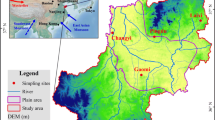Abstract
Three sampling cross sections along the south path starting from the Tropics through the vapor passage in the Yunnan-Guizhou Plateau to the middle-low reaches of the Yangtze River, the north path from West China, via North China, to Japan under the westerlies, and the plateau path from South Asia over the Himalayas to the northern Tibetan Plateau, are set up, based on the IAEA (International Atomic Energy Agency)/WMO global survey network and sampling sites on the Tibetan Plateau. The variations, and the relationship with precipitation and temperature, of the δ18O in precipitation along the three cross sections are analyzed and compared. Along the south path, the seasonal differences of mean δ18O in precipitation are small at the stations located in the Tropics, but increase markedly from Bangkok towards the north, with the δ18O in the rainy season smaller than in the dry season. The δ18O values in precipitation fluctuate on the whole, which shows that there are different vapor sources. Along the north path, the seasonal differences of the mean δ18O in precipitation for the stations in the west of Zhengzhou are all greater than in the east of Zhengzhou. During the cold half of the year, the mean δ18O in precipitation reaches its minimum at Ürümqi with the lowest temperature due to the wide, cold high pressure over Mongolia, then increases gradually with longitude, and remains at roughly the same level at the stations eastward from Zhengzhou. During the warm half of the year, the δ18O values in precipitation are lower in the east than in the west, markedly influenced by the summer monsoon over East Asia. Along the plateau path, the mean δ18O values in precipitation in the rainy season are correspondingly high in the southern parts of the Indian subcontinent, and then decrease gradually with latitude. A sharp depletion of the stable isotopic compositions in precipitation takes place due to the very strong rainout of the stable isotopic compositions in vapor in the process of lifting over the southern slope of the Himalayas. The low level of the δ18O in precipitation is from Nyalam to the Tanggula Mountains during the rainy season, but δ18O increases persistently with increasing latitude from the Tanggula Mountains to the northern Tibetan Plateau because of the replenishment of vapor with relatively heavy stable isotopic compositions originating from the inner plateau. During the dry season, the mean δ18O values in precipitation basically decrease along the path from the south to the north. Generally, the mean δ18O in precipitation during the rainy season is lower than in the dry season for the regions controlled by the monsoons over South Asia or the plateau, and opposite for the regions without a monsoon or with a weak monsoon.
Similar content being viewed by others
References
Araguas, L., K. Froehlich, and K. Rozanski, 1998: Stable isotope composition of precipitation over Southeast Asia.J. Geophys. Res.,103, 28721–28742.
Dansgaard, W., 1953: The abundance of18O in atmospheric water and water vapor.Tellus,5(4), 461–469.
Dansgaard, W., 1964: Stable isotopes in precipitation.Tellus,16(4), 436–468.
IAEA/WMO, 2001: The GNIP Data Release 3. [Available online from http://www.iaea.org.programs /ri/gnip/gnipmain.htm].
Jouzel, J., K. Froehlich, and U. Schotterer, 1997: Deuterium and oxygen-18 in present-day precipitation: Data and modeling.Hydrological Sciences Journal,42(5), 747–763.
Rozanski, K., S. J. Johnson, and U. Schotterer, 1997: Reconstruction of past climates from stable isotope records of palaeo-precipitation preserved in continental archives.Hydrological Sciences Journal,42(5), 725–745.
Thompson, L. G., T. Yao, E. M. Thompson, M. E. Davis, K. A. Henderson, and P. N. Lin, 2000: A highresolution millennial record of South Asian monsoon from Himalayan Ice Cores.Science,289, 1916–1919.
Tian Lide, Yao Tandong, Yang Zhihong, and Pu Jianchen, 1997: A 4-year’s study of stable isotope in precipitation on the Tibetan Plateau.Cryosphere,3, 32–36.
Yao Tandong, 1999: Abrupt climatic changes on the Tibetan Plateau during the last Ice Age.Science in China (D),42(3), 358–368.
Zhang Bozheng, 1994: Distribution characters of stable isotopes of waters in the Qinghai Lake area and their evolutional law.Evolution of Recent Environment in Qinghai Lake and its Prediction, Science Press, Beijing, 29–40. (in Chinese)
Zhang Xinping, and Yao Tandong, 1994: World spatial characteristics of oxygen isotope ratio in precipitation.Journal of Glaciology and Geocryology,16(3), 202–210. (in Chinese)
Zhang Xinping, Shi Yafeng, and Yao Tandong, 1995a: Variational features of precipitation δ18O in Northeast Qinghai-Tibet Plateau.Science in China (B),38(7), 854–864.
Zhang Xinping, Yao Tandong, and Tian Lide, 1995b: A study on spatial and temporal distribution of δ18O in precipitation in the Tibetan Plateau.Cryosphere,1(1), 27–31.
Zhang Xinping, M. Nakawo, K. Fujita, Yao Tandong, and Han Jiankang, 2001: The variation of precipitation δ18O in Langtang Valley, Himalayas.Science in China (D),44(9), 769–778.
Zhang Xinping, M. Nakawo, Yao Tandong, Han Jiankang, and Xie Zichu, 2002: Variations of stable isotopic compositions in precipitation on the Tibetan Plateau and its Adjacent Regions.Science in China (D),45(6), 481–493.
Zhang Xinping, Yao Tandong, Liu Jingmiao, Tian Lide, and M. Nakawo, 2003: Simulations of stable isotopic fractionation in mixed cloud in middle latitudes-Taking the precipitation at Ürümqi as an example.Adv. Atmos. Sci.,20(2), 261–268.
Author information
Authors and Affiliations
Corresponding author
Rights and permissions
About this article
Cite this article
Zhang, X., Liu, J., Tian, L. et al. Variations of δ18O in precipitation along vapor transport paths. Adv. Atmos. Sci. 21, 562–572 (2004). https://doi.org/10.1007/BF02915724
Received:
Revised:
Issue Date:
DOI: https://doi.org/10.1007/BF02915724




